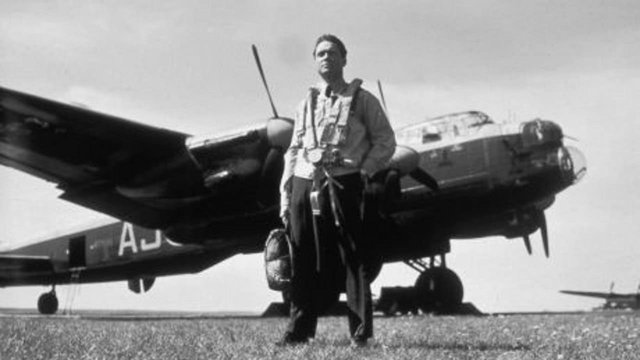Retro Film Review: The Dam Busters (1955)

In 1980s I used to spend a lot of free time playing various games on my ZX Spectrum home computer. Among them was The Dam Busters, one of the rare computer simulations based on the real historical event. The event in question was perhaps not the important military operation of World War Two, but it was definitely one of the more spectacular. Its dramatic potential was, of course, recognised by the filmmakers and some three decades before being turned into computer game. Twelve years after the event itself, The Dam Busters became feature film, directed by Michael Anderson.
The plot begins in spring of 1942. Hitler's war machine is wrestling with Red Army deep in the Russian heartland, while the rest of Europe is firmly under Axis control and it would remain so for the time being, since Allied ground forces in Britain are still unprepared to mount invasion. The best Allies can do is to send hundreds of bombers over Germany and other occupied countries in order to attack industrial facilities, communications and infrastructure and thus weaken Hitler's war potential. British scientist Barnes Wallis (played by Michael Redgrave) is convinced that the strategy isn't working and that many raids on individual factories won't significantly shorten the war. Instead he dreams of a single strike that would knock out entire Ruhr, industrial heart of Germany. Ruhr is dependant on water supplies stored by three huge dams - Oeden, Moene and Sorpe - and if they are destroyed, the factories should permanently stop working. Destruction of these dams requires huge quantity of explosives, completely new bomb design and quite new method of delivery. Wallis has solved those problems in theory, but he would have to wait almost a year before he receives necessary funds, resources and personnel from military and civilian bureaucrats. While the project enters in the final stages of R&D, RAF has picked up a select group of best pilots and formed Squadron 617, led by Wing Commander Guy Gibson (played by Richard Todd). Before they carry out the attack, they must spend months in rigorous training, because the operation requires low-level night flying, extremely precise speed and altitude. Finally, on May 16th 1943, Gibson and his men begin the mission, called Operation Chastise, that would be remembered as one of the most spectacular and daring air raids of World War Two.
When R.C. Sheriff began writing the script for this film, he probably thought that the event itself was interesting enough, and that the film didn't require melodramatic subplots or character development. It was very fortunate, because many similar films based on true stories sometimes suffer because of the scriptwriters' need to make them dramatically appealing. The ascetic plot of The Dam Busters, however, has some interesting elements - Wallis' struggle with technical problems and red tape in the first part of the film is nicely contrasted with Gibson's training and the raid itself. Those two characters also have a good interaction - veteran British actor Michael Redgrave plays Barnes Wallis as very emotional man, extremely dedicated to his job to the point of near madness; Richard Todd, on the other hand, plays Gibson as the embodiment of British "stiff-upper-lip" ideals and pragmatism. Gibson and Wallis, however, have more in common that they are ready to admit; Gibson's inner feelings and dilemmas are only hinted, but that doesn't make those scenes less powerful.
The thing that put The Dam Busters in the annals of the seventh art is the raid scene that would decades later inspire George Lucas for the final battle in Star Wars: A New Hope. The inevitable comparisons between those two scenes are rather bad for Anderson's film; special effects are unimpressive, even for 1950s standards, and the darkness and black-and- white photography make it even less appealing. The impression is somewhat improved with scenes that feature some nice aerial photography and authentic Lancaster bombers. The latter were provided by RAF, which, in the end, received hagiographic treatment by Anderson and other filmmakers. The Dam Busters ends with raid, being portrayed as successful; controversies of its overall success and true effectiveness of the Operation Chastise, as well as the achievements of the entire strategic bombing campaign, were left to future historians.
Another controversy surrounding this film came out of filmmakers' need to make this film as historically accurate as possible. Gibson had a black dog named "Nigger", and the dog is not just featured and often being referenced in the film, but its name was used as code word during the raid itself. US version later had the objectionable word dubbed with the word "Trigger", and some scene featuring it were edited out, making some of the scenes incomprehensible. Whether Gibson was genuine racist or not, we would never know, since he got killed later in war. This little detail could remind the 1990s audience about the fact that the notions of political correctness we take for granted today weren't there only few decades ago. And we could also be reminded that even the people we consider to be the heroes aren't always perfect.
RATING: 7/10 (+++)
(Note: The text in its original form was posted in Usenet newsgroup rec.arts.movies.reviews on December 17th 1999)
Blog in Croatian https://draxblog.com
Blog in English https://draxreview.wordpress.com/
Cent profile https://beta.cent.co/@drax
Minds profile https://www.minds.com/drax_rp_nc
Brave browser: https://brave.com/dra011
BTC donations: 1EWxiMiP6iiG9rger3NuUSd6HByaxQWafG
ETH donations: 0xB305F144323b99e6f8b1d66f5D7DE78B498C32A7
Movie URL: https://www.themoviedb.org/movie/13210-the-dam-busters
Critic: AA